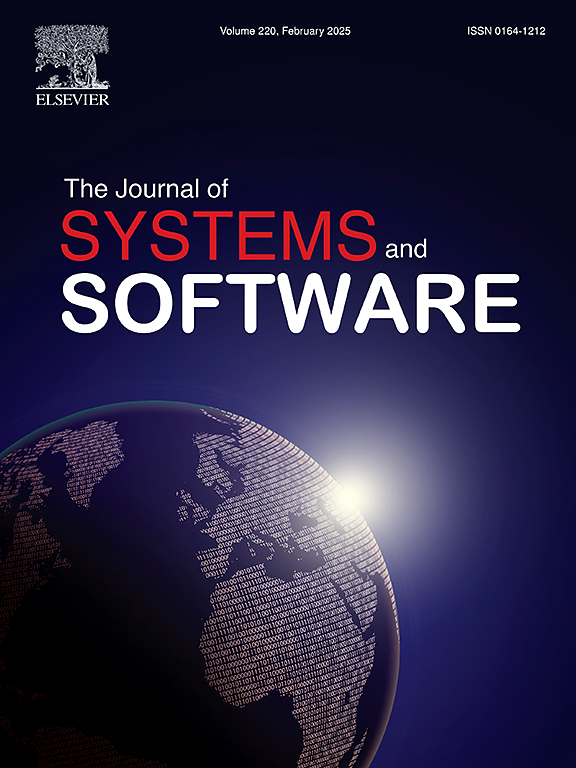Different approaches for testing body sensor network applications
IF 3.7
2区 计算机科学
Q1 COMPUTER SCIENCE, SOFTWARE ENGINEERING
引用次数: 0
Abstract
Body Sensor Networks (BSNs) offer a cost-effective way to monitor patients’ health and detect potential risks. Despite the growing interest attracted by BSNs, there is a lack of testing approaches for them. Testing a Body Sensor Network (BSN) is challenging due to its evolving nature, the complexity of sensor scenarios and their fusion, the potential necessity of third-party testing for certification, and the need to prioritize critical failures given limited resources. This paper addresses these challenges by proposing three BSN testing approaches: PASTA, ValComb, and TransCov. These approaches share common characteristics, which are described through a general framework called GATE4BSN. PASTA simulates patients with sensors and models sensor trends using a Discrete Time Markov Chain (DTMC). ValComb explores various health conditions by considering all sensor risk level combinations, while TransCov ensures full coverage of DTMC transitions. We empirically evaluate these approaches, comparing them with a baseline approach in terms of failure detection. The results demonstrate that PASTA, ValComb, and TransCov uncover previously undetected failures in an open-source BSN and outperform the baseline approach. Statistical analysis reveals that PASTA is the most effective, while ValComb is 76 times faster than PASTA and nearly as effective.
测试身体传感器网络应用的不同方法
身体传感器网络(BSNs)提供了一种具有成本效益的方式来监测患者的健康状况并检测潜在风险。尽管BSNs吸引了越来越多的兴趣,但缺乏针对它们的测试方法。人体传感器网络(BSN)的测试具有挑战性,因为其不断发展的性质、传感器场景及其融合的复杂性、第三方测试认证的潜在必要性,以及在资源有限的情况下需要优先考虑关键故障。本文通过提出三种BSN测试方法:PASTA、ValComb和TransCov来解决这些挑战。这些方法具有共同的特征,这些特征通过称为GATE4BSN的通用框架进行描述。PASTA使用离散时间马尔可夫链(DTMC)模拟具有传感器的患者和传感器趋势模型。ValComb通过考虑所有传感器风险水平组合来探索各种健康状况,而TransCov则确保全面覆盖DTMC转换。我们根据经验评估这些方法,将它们与故障检测方面的基线方法进行比较。结果表明,PASTA、ValComb和TransCov发现了开源BSN中以前未检测到的故障,并且优于基线方法。统计分析显示,PASTA是最有效的,而ValComb比PASTA快76倍,几乎同样有效。
本文章由计算机程序翻译,如有差异,请以英文原文为准。
求助全文
约1分钟内获得全文
求助全文
来源期刊

Journal of Systems and Software
工程技术-计算机:理论方法
CiteScore
8.60
自引率
5.70%
发文量
193
审稿时长
16 weeks
期刊介绍:
The Journal of Systems and Software publishes papers covering all aspects of software engineering and related hardware-software-systems issues. All articles should include a validation of the idea presented, e.g. through case studies, experiments, or systematic comparisons with other approaches already in practice. Topics of interest include, but are not limited to:
•Methods and tools for, and empirical studies on, software requirements, design, architecture, verification and validation, maintenance and evolution
•Agile, model-driven, service-oriented, open source and global software development
•Approaches for mobile, multiprocessing, real-time, distributed, cloud-based, dependable and virtualized systems
•Human factors and management concerns of software development
•Data management and big data issues of software systems
•Metrics and evaluation, data mining of software development resources
•Business and economic aspects of software development processes
The journal welcomes state-of-the-art surveys and reports of practical experience for all of these topics.
 求助内容:
求助内容: 应助结果提醒方式:
应助结果提醒方式:


